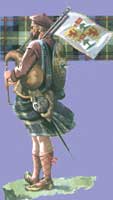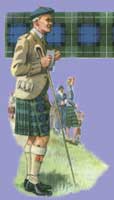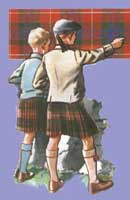Click below to find other Scottish Clans
|
|
|
This is one of the royal clans of Scotland descended from Prince Loarn of Dalriada (circa fifth century AD). The Farquharsons are a clan which has a Celtic origin and is an ancient family in Scottish history. It is said that the clan and family are named after the fourth son of one Alexander Cier (Shaw) of Rothiemurcus who was in possession of lands near the river Dee this area was known locally in Aberdeenshire as the braes of mar.
At the battle of Pinkie in 1547 Finlay (MacFionlaigh) Mor was killed as he carried the Standard into battle. This was to lead to the very young Mary Queen of Scots being rushed away and hidden before transferring her to safety in France . |
|
 |
Findlay had been married twice and had nine sons in the two marriages. Some of his sons were as follows, Craigniety, Monaltrie, Whitehouse, Finzean, Allanquoich, Inverey, Tullochcoy, Broughdearg, and Achriachan.
The clan soon built a reputation for being aggressive but well disciplined fighters. In fact they were starting to be called the ‘Fighting Farquharsons' In the year 1645, Farquharson of Invercauld and the clan fought with the Marquis of Montrose on behalf of Charles I. They fought every battle of the 1715 campaign and at the end were very wanted men. The Farquharson clan, then led by Farquharson of Monaltrie, Rose again in support of Prince Charles Edward Stuart (Bonnie Prince Charlie) during the Jacobite campaign of 1745 to have the rightful King on the throne of Scotland. |
This all ended for the time being in 1746 when the battle of Culloden swept away the Jacobite cause in less than half an hour. Francis Farquharson of Monaltrie was captured by the Government soldiers after the battle and handed over to the English. He was imprisoned and then sent down to the Bloody tower of London for execution, on the very morning that he and two other Highland officers were to be disposed of a reprieve came through. He was released but unfortunately died four years almost to the day later in 1750, he was succeeded by his son James who died in the year 1805.
However, in the year 1748, the Laird of Invercauld was required to lease his castle to the Hanoverian government for 90 years as a military station. Thankfully, they withdrew a long time ago.
In 1806, the right of Tailzie fell upon Catherine Farquharson of Invercauld, wife of Captain James Ross, who adopted the name of Farquharson as required under Scottish law. From Catherine and James, the present Farquharson of Invercauld is descended.
|
Chief : Farquharson of Invercauld
Clan Seat: Invercauld House and Braemar Castle , Aberdeenshire
Plant: Scots Fir
Memorials : None |
|
|
| Back to Top |
There are three branches to this ancient Celtic clan. The Fergusson's of Kilkerran hailed from Ayrshire and have held their land since the days of King Robert the Bruce while the Fhearghuis of Stra-chur, hereditary Maers of Glenshillich, hailed from Argyll. The third, the Fergusson's of Dunfallandry, have been chiefs of the clan in Athol for many centuries. As to whether they are related to one another, no one is quite sure.
The Clan Fergusson in Argyllshire is descended from one Fergus Mor MacErc, who was a very early King of Scots of Dalriada, there is evidence linking the Ayrshire Fergusson family clan and the Dumfries family too with the Fergus, Prince of Galloway in the year 1161. |
|
 |
It was noted that a Fergusson was granted charter from King Robert the Bruce after the battle of Bannockburn when the English King Edward the second was soundly beaten and put to flight on the twenty-fourth day of June 1314. It would seem apparent that
the holder of the charter would have been a loyal Bruce subject and
most likely that they had taken part in the most famous battle of
Scotland 's History.
The very first recorded version of their name is in Kilkerran and the person was called John Fergusson and that was in the year 1464. |
The Ayrshire Fergusson's adopted the protestant faith during the reformation. Sir John Fergusson of Kilkerran, fought for the royalist cause during the civil war.. His grandson was created a Baronet of Nova Scotia in The year 1703.
Robert Fergusson ‘the plotter' was involved in the Ryehouse Plot but escaped and died in 1714. The clan has produced some quite interesting individuals. To name but a few.
James Fergusson, Major-General, fought at Blenheim under Marlborough . Adam Fergusson was a historian and moral philosopher, Robert Fergusson was a poet and Sir William Fergusson was a Fellow of the Royal Society. ‘Annie Laurie', the famed heroine of the song bearing her name was the wife of Fergusson of Craigdarroch.
Last who may be noted was Sir Adam Ferguson, son of the above and long a familiar friend of Sir Walter Scott, who as a Captain of the 101st Regiment read the Sixth Canto of The Lady of the Lake to his company in the lines of Torres Veciras, afterwards became keeper of the Regalia of Scotland, and was knighted in 1822. Regarding him Lockhart in his Life of Scott recounts an amusing incident in which the poet Crabbe was concerned. He quotes the Life of Crabbe, in which that poet describes how on this occasion he met "Lord Errol, and the MacLeod, and the Fraser, and the Gordon, and the Ferguson ," and conversed at dinner with Lady Glengarry. In a note regarding the allusion to Fergusson, Lockhart says: "Sir Walter's friend, the Captain of Huntly Burn, did not, as far as I remember, sport the Highland dress on this occasion, but no doubt his singing of certain Jacobite songs, etc., contributed to make Crabbe set him down for a chief of a clan. Sir Adam, however, is a Highlander."
|
Chief: Fergusson of Kilkerran
Clan Seat: Kilkerran Tower , Ayrshire ; Glenshillich, in Strachur
Plant: None
Memorials: None |
|
| Back to Top |
This clan is an ancient Celtic one and the first Forbes to bear the name was John, a contemporary of King William the lion. He succeeded to the Duthus of Forbes, probably by marrying its heiress, which had been held from the days of O'Conochar bear killer. The clan was looked upon as a good family and were strong and brave.
Their clan and family lands spread from the mountainous ranges near Aberdeen to the coastal areas of Banff and Buchan. It is a huge area and took a lot of work and cooperation by the Forbes family Clan. |
|
 |
During the Wars of Independence, Alexander Forbes defended Urquhart Castle against Edward I, and was killed, slaughtered with its entire garrison that was in the year 1304. The Forbes family were well represented on the most famous day in Scotland 's bloody history.
On the twenty-fourth of June 1314 Edward of England approached the Bannockburn near the town of Stirling . Edward was confidant of an easy victory over the Scots who were led By King Robert the Bruce. Edward the second was soundly beaten on that day and retreated at haste over the border to his native England . |
From Sir John Forbes of Forbes, a contemporary of King Robert II, is descended the Lords Pitsligo. Alexander Forbes of Forbes was created Lord Forbes by Queen Joan Beaufort; widow of King James The first and Regent of Scotland of Scotland in 1442 and the sixth Lord Forbes was greatly admired by King James the fifth. The tenth Lord fought under the banner of Gustavus Adolphus of Sweden during the 30 years wars
Charles the seconds life was saved by Sir Alexander Forbes of Tolquhoun at the battle of Worcester (this branch produced the Lairds of Culloden) this battle was a bad day for the royalist army as they were decimated from the start. The army didn't seem to have any sort of leadership on the day and this caused confusion among the individual commanders. There were too many acts of bravery that day to ever have a true record of the sacrifices made by the Scottish clans. It was a slaughter and many Clan members from all the families died.
On the day of Culloden the Forbes stood facing the government army which held at least three thousand Campbells . The fourth Lord Pitsligo fought at Culloden on behalf of Prince Charles Edward Stuart because he believed that the Prince was the legitimate heir to the Scottish crown and that the Hanoverians were in fact usurpers of the same crown. The Craigievar branch is descended from Patrick Forbes of Corse, armour-bearer to King James III. Craigievar Castle is now in the hands of the National Trust for Scotland . |
Chief: Lord Forbes
Clan Seat: Castle-Forbes, and Drumminor Castle , Aberdeenshire
Plant: Broom
Memorials : None |
|
| Back to Top |
| It is a possibility that the Fraser Clan originated in France . There is a man named as Gilbert in the year 1109, But the Frasers as we would know them first appear in Scotland around the year of 1160, when Simon Fraser made a gift of a church at Keith in East Lothian , to the monks at Kelso Abbey. The Frasers moved into Tweeddale in the twelfth and thirteenth centuries and from there to the counties of Stirling , Angus, Inverness and Aberdeen . About five generations later, Sir Simon Fraser [the great Scottish Patriot] was captured fighting for Robert the Bruce, and executed with great cruelty by Edward I in 1306. The patriot's line ended with two co-heiresses. Sir Andrew Fraser of Touch-Fraser, cousin of the patriot, was the father of Sir Alexander Fraser of Cowie [ancestor of the Frasers of Philorth], Sir Simon Fraser [ancestor of the Frasers of Lovat], Sir Andrew Fraser and Sir James Fraser of Frendraught. |
|
 |
Sir Simon was avenged for his horrific death when King Robert the Bruce defeated the huge English army at the battle of Bannockburn on the twenty-fourth day of June 1314. The English had been commanded by Edward the second, but the Scots forced him to hastily retreat back across the border to his own country.
Hugh Fraser, said to be no relation to Sir Simon, was styled ‘of Lovat' and he is the progenitor of the clan designed as such. His son was made Baron by King James the second. We are told that the Lovat clan are a distinctly different people to the Frasers |
Hugh, ninth Lord Lovat, died without heir-male but had daughters, the eldest of which, Amelia, had married a Mackenzie and pro-Jacobite in 1714. The eleventh Lord, as Tailzie to the clan, first brought the Frasers on the side of the government but, having fallen out with the Hanoverian regime, switched side and fought at Culloden in 1746 on behalf of Prince Charles Edward Stuart (Bonnie prince Charlie) who was the champion of the Jacobite cause to put the rightful monarch back on the Scottish throne. For this, he was both attainted and beheaded in 1746
The title, however, was revived in 1836 by Queen Victoria and settled upon Thomas Fraser of Streichen and Lovat. It is from this Thomas that the present Lord Lovat is descended but there has been an objection to this succession many times. In fact, it appears that Fraser of Philorth, now represented by Lord Saltoun, should be heir to the Lordship of Fraser. |
Chief: Lord Fraser
Clan seat: Castle Fraser, Sauchen
Plant: Yew
Memorials: Rathen Kirk |
|
Click below to find other Scottish Clans
|
|
Back to Top
|